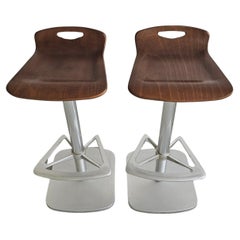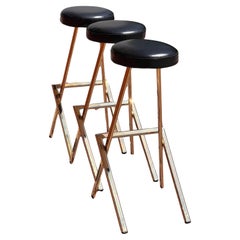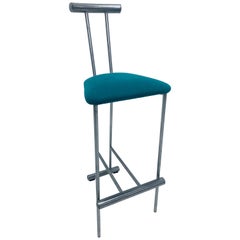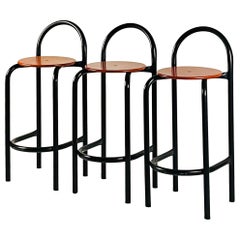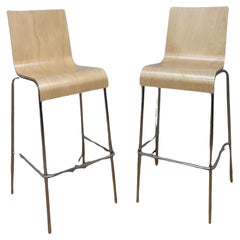Postmodern Bar Stools
Vintage 1980s Spanish Post-Modern Stools
Aluminum
Vintage 1980s Spanish Post-Modern Stools
Steel
Vintage 1970s Post-Modern Stools
Brass
Vintage 1980s Unknown Post-Modern Stools
Steel
Vintage 1980s American Post-Modern Stools
Metal
Vintage 1980s American Post-Modern Stools
Metal
Vintage 1970s American Mid-Century Modern Stools
Lucite
Late 20th Century Unknown Post-Modern Stools
Wood, Walnut
Vintage 1980s Italian Post-Modern Stools
Steel
Vintage 1980s North American Mid-Century Modern Stools
Chrome
Late 20th Century Italian Post-Modern Stools
Steel
Late 20th Century Italian Post-Modern Stools
Metal
Late 20th Century Italian Post-Modern Stools
Steel
Vintage 1980s Italian Post-Modern Stools
Metal
Early 2000s German Post-Modern Stools
Metal
Vintage 1980s American Post-Modern Stools
Faux Leather
20th Century German Post-Modern Stools
Metal
1990s Italian Post-Modern Stools
Steel
Vintage 1980s Post-Modern Stools
Metal
Early 2000s Italian Futurist Stools
Steel
Vintage 1980s American Post-Modern Stools
Aluminum, Steel
Late 20th Century Italian Post-Modern Stools
Metal
Late 20th Century American Post-Modern Stools
Aluminum
20th Century American Post-Modern Ottomans and Poufs
Fabric
Late 20th Century Italian Post-Modern Stools
Stainless Steel
Late 20th Century Italian Post-Modern Stools
Stainless Steel
20th Century American Mid-Century Modern Stools
Fabric, Lacquer
Vintage 1970s Danish Post-Modern Stools
Chrome
Vintage 1980s Italian Post-Modern Stools
Steel
Late 20th Century Italian Post-Modern Stools
Metal
Vintage 1980s American Post-Modern Stools
Metal
Vintage 1980s Stools
Brass
Vintage 1980s Post-Modern Stools
Metal
20th Century Italian Post-Modern Stools
Metal
Late 20th Century American Stools
Steel
Late 20th Century American Stools
Brass
20th Century Italian Post-Modern Stools
Metal
Vintage 1980s Italian Mid-Century Modern Stools
Metal, Chrome
Vintage 1980s Italian Post-Modern Stools
Steel
20th Century French Post-Modern Stools
Steel
1990s American Post-Modern Stools
Stainless Steel
Late 20th Century Post-Modern Stools
Chrome
21st Century and Contemporary Italian Post-Modern Stools
Steel
1990s Spanish Post-Modern Stools
Steel
Late 20th Century North American Post-Modern Stools
Wood
Late 20th Century North American Post-Modern Stools
Wood
Vintage 1980s Post-Modern Stools
Stainless Steel, Steel
Late 20th Century Italian Post-Modern Stools
Metal
Early 2000s Swedish Post-Modern Stools
Steel
20th Century American Mid-Century Modern Stools
Velvet
Late 20th Century Italian Post-Modern Stools
Chrome
Vintage 1980s American Post-Modern Living Room Sets
Iron
Early 2000s Ottomans and Poufs
Fabric
1990s Italian Post-Modern Chairs
Metal
Vintage 1980s American Post-Modern Stools
Metal
Vintage 1980s American Post-Modern Stools
Metal, Aluminum
Late 20th Century Italian Post-Modern Stools
Steel
Late 20th Century European Post-Modern Stools
Metal
Vintage 1980s American Post-Modern Stools
Aluminum, Stainless Steel
Vintage 1970s American Post-Modern Stools
Wrought Iron
- 1
Postmodern Bar Stools For Sale on 1stDibs
How Much are Postmodern Bar Stools?
A Close Look at Post-modern Furniture
Postmodern design was a short-lived movement that manifested itself chiefly in Italy and the United States in the early 1980s. The characteristics of vintage postmodern furniture and other postmodern objects and decor for the home included loud-patterned, usually plastic surfaces; strange proportions, vibrant colors and weird angles; and a vague-at-best relationship between form and function.
ORIGINS OF POSTMODERN FURNITURE DESIGN
- Emerges during the 1960s; popularity explodes during the ’80s
- A reaction to prevailing conventions of modernism by mainly American architects
- Architect Robert Venturi critiques modern architecture in his Complexity and Contradiction in Architecture (1966)
- Theorist Charles Jencks, who championed architecture filled with allusions and cultural references, writes The Language of Post-Modern Architecture (1977)
- Italian design collective the Memphis Group, also known as Memphis Milano, meets for the first time (1980)
- Memphis collective debuts more than 50 objects and furnishings at Salone del Milano (1981)
- Interest in style declines, minimalism gains steam
CHARACTERISTICS OF POSTMODERN FURNITURE DESIGN
- Dizzying graphic patterns and an emphasis on loud, off-the-wall colors
- Use of plastic and laminates, glass, metal and marble; lacquered and painted wood
- Unconventional proportions and abundant ornamentation
- Playful nods to Art Deco and Pop art
POSTMODERN FURNITURE DESIGNERS TO KNOW
- Ettore Sottsass
- Robert Venturi
- Alessandro Mendini
- Michele de Lucchi
- Michael Graves
- Nathalie du Pasquier
VINTAGE POSTMODERN FURNITURE ON 1STDIBS
Critics derided postmodern design as a grandstanding bid for attention and nothing of consequence. Decades later, the fact that postmodernism still has the power to provoke thoughts, along with other reactions, proves they were not entirely correct.
Postmodern design began as an architectural critique. Starting in the 1960s, a small cadre of mainly American architects began to argue that modernism, once high-minded and even noble in its goals, had become stale, stagnant and blandly corporate. Later, in Milan, a cohort of creators led by Ettore Sottsass and Alessandro Mendini — a onetime mentor to Sottsass and a key figure in the Italian Radical movement — brought the discussion to bear on design.
Sottsass, an industrial designer, philosopher and provocateur, gathered a core group of young designers into a collective in 1980 they called Memphis. Members of the Memphis Group, which would come to include Martine Bedin, Michael Graves, Marco Zanini, Shiro Kuramata, Michele de Lucchi and Matteo Thun, saw design as a means of communication, and they wanted it to shout. That it did: The first Memphis collection appeared in 1981 in Milan and broke all the modernist taboos, embracing irony, kitsch, wild ornamentation and bad taste.
Memphis works remain icons of postmodernism: the Sottsass Casablanca bookcase, with its leopard-print plastic veneer; de Lucchi’s First chair, which has been described as having the look of an electronics component; Martine Bedin’s Super lamp: a pull-toy puppy on a power-cord leash. Even though it preceded the Memphis Group’s formal launch, Sottsass’s iconic Ultrafragola mirror — in its conspicuously curved plastic shell with radical pops of pink neon — proves striking in any space and embodies many of the collective’s postmodern ideals.
After the initial Memphis show caused an uproar, the postmodern movement within furniture and interior design quickly took off in America. (Memphis fell out of fashion when the Reagan era gave way to cool 1990’s minimalism.) The architect Robert Venturi had by then already begun a series of plywood chairs for Knoll Inc., with beefy, exaggerated silhouettes of traditional styles such as Queen Anne and Chippendale. In 1982, the new firm Swid Powell enlisted a group of top American architects, including Frank Gehry, Richard Meier, Stanley Tigerman and Venturi to create postmodern tableware in silver, ceramic and glass.
On 1stDibs, the vintage postmodern furniture collection includes chairs, coffee tables, sofas, decorative objects, table lamps and more.
Finding the Right Stools for You
Stools are versatile and a necessary addition to any living room, kitchen area or elsewhere in your home. A sofa or reliable lounge chair might nab all the credit, comfort-wise, but don’t discount the roles that good antique, new and vintage stools can play.
“Stools are jewels and statements in a space, and they can also be investment pieces,” says New York City designer Amy Lau, who adds that these seats provide an excellent choice for setting an interior’s general tone.
Stools, which are among the oldest forms of wooden furnishings, may also serve as decorative pieces, even if we’re talking about a stool that is far less sculptural than the gracefully curving molded plywood shells that make up Sōri Yanagi’s provocative Butterfly stool.
Fawn Galli, a New York interior designer, uses her stools in the same way you would use a throw pillow. “I normally buy several styles and move them around the home where needed,” she says.
Stools are smaller pieces of seating as compared to armchairs or dining chairs and can add depth as well as functionality to a space that you’ve set aside for entertaining. For a splash of color, consider the Stool 60, a pioneering work of bentwood by Finnish architect and furniture maker Alvar Aalto. It’s manufactured by Artek and comes in a variety of colored seats and finishes.
Barstools that date back to the 1970s are now more ubiquitous in kitchens. Vintage barstools have seen renewed interest, be they a meld of chrome and leather or transparent plastic, such as the Lucite and stainless-steel counter stool variety from Indiana-born furniture designer Charles Hollis Jones, who is renowned for his acrylic works. A cluster of barstools — perhaps a set of four brushed-aluminum counter stools by Emeco or Tubby Tube stools by Faye Toogood — can encourage merriment in the kitchen. If you’ve got the room for family and friends to congregate and enjoy cocktails where the cooking is done, consider matching your stools with a tall table.
Whether you need counter stools, drafting stools or another kind, explore an extensive range of antique, new and vintage stools on 1stDibs.
- 1stDibs ExpertNovember 2, 2021The most comfortable bar stool is a matter of preference. There are many different types of bar stools for your house, and many different comfy versions have been developed over time. To select the best one, we suggest thinking about height, weight, design and fabric so you can find the best set for your preferences and budget. Shop a collection of antique, vintage and contemporary bar stools from some of the world’s top dealers on 1stDibs.
- 1stDibs ExpertFebruary 22, 2021The height of a bar stool is typically around 28 to 38 inches tall. This is because bar tops are usually around 40 to 42 inches high, so bar stools need to be under this height in order to provide ample leg room.
- Why is it called a bar stool?1 Answer1stDibs ExpertNovember 13, 2024Why it is called a bar stool has to do with where you typically place this type of furniture. Usually featuring seat heights of 28 to 33 inches, these chairs situate a user at a comfortable level to eat and drink at a bar, whether in a home or in a restaurant. Bar stools are taller than seating intended for use at kitchen counters, known as counter stools, which usually have a seat height of 24 to 27 inches. On 1stDibs, find a diverse assortment of counter stools.
- 1stDibs ExpertApril 5, 2022Yes, bar stools are taller than counter stools. The average height of counter stools is 24 inches, and they are best suited for counter height tables and kitchen islands. Barstools are typically an additional five to six inches taller to fit the height of traditional bar counters. Shop a wide selection of bar stools and counter-height stools on 1stDibs.
- 1stDibs ExpertApril 26, 2024The difference between bar stools and counter stools comes down to height. Bar stools are usually between 28 and 32 inches tall to provide comfortable seating at bars and bar-height tables. To pair with kitchen counters and counter-height tables, counter stools are normally 24 to 27 inches tall. Find a large collection of dining stools on 1stDibs.
- 1stDibs ExpertFebruary 21, 2023Whether saddle bar stools are comfortable is largely a matter of personal opinion. However, some people find the curved seats featured on these stools supportive because they conform to the body's contours. Find a variety of saddle bar stools on 1stDibs.
- 1stDibs ExpertApril 5, 2022A standard bar stool will sit around 29 to 32 inches high, and extra-tall bar stools will sit around 33 to 36 inches high. To ensure the best fit for your space, measure the height of the bar or table you want to accent. Shop a wide selection of bar stools on 1stDibs.
- 1stDibs ExpertApril 5, 2022The comfort of a rattan bar stool is really a matter of preference. Some styles are crafted with a back or cushion for additional comfort, while some may support the addition of a cushioned seat. On 1stDivs, find a range of rattan bar stool styles to suit any preference.
- 1stDibs ExpertSeptember 25, 2019
Since counters are generally 34 to 39 inches high, counter stools should be 24 to 27 inches tall; bars are 40 to 46 inches from the ground, so bar stools typically stand 30 to 36 inches tall.
- 1stDibs ExpertApril 5, 2022Counter height bar stools are stools that typically have a seat around 24 inches to 27 inches high and are designed to provide seating along a bar or at counter height tables. On 1stDibs, find an array of counter height bar stools from top sellers.
- 1stDibs ExpertFebruary 13, 2023The best wood for bar stools is largely a matter of personal preference. Walnut, oak, cherry and birch are commonly used materials. On 1stDibs, find a selection of bar stools from some of the world's top sellers.
- 1stDibs ExpertMarch 22, 2022To identify Marcel Breuer bar stools, start by examining the frame. Genuine models will usually feature smooth, welded ends. Most reproductions have end caps instead. You can also look for a sticker that bears the model name on the underside of the seat. On 1stDibs, find a range of expertly vetted Marcel Breuer bar stools.
